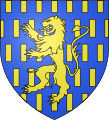Guelders
Duchy of Guelders | |||||||||
|---|---|---|---|---|---|---|---|---|---|
| 1096–1795 | |||||||||
 Duchy of Guelders with Gelderland, about 1477 | |||||||||
| Status | State of the Holy Roman Empire | ||||||||
| Capital | Geldern | ||||||||
| Government | Principality | ||||||||
| Historical era | Middle Ages, Renaissance | ||||||||
| 1096 | |||||||||
• Raised to duchy | 1339 | ||||||||
• Held by Jülich | 1393-1423 | ||||||||
• Acquired by Burgundy | 1473 | ||||||||
| 1581 | |||||||||
• Annexed by France | 1795 | ||||||||
| |||||||||
Guelders or Gueldres (Dutch: Gelre, German: Geldern) is the name of a historical county. This became a duchy (lands ruled by a duke or duchess) of the Holy Roman Empire, in the Low Countries.
Geography
[change | change source]The duchy was named after the town of Geldern (Gelder) in what is now called Germany. The present province of Gelderland (English also Guelders) in the Netherlands occupies most of the area. However, the former duchy also included parts of the present Dutch province of Limburg and the territories in the present-day German state of North Rhine-Westphalia that were acquired by Prussia in 1713.
The duchy had four special parts, which had their own centres:
- the quarter of Roermond, also called the Overkwartier (Upper Quarter) or Upper Guelders. This was upstream on both sides of the Maas. It included the town of Geldern as well as Erkelenz, Goch, Nieuwstadt, Venlo and Straelen;
and was separated from the Lower Quarters (Gelderland):
- the quarter of Zutphen, also called the Achterhoek. This was east of the IJssel and north to the Rhine. It included towns like Doesburg, Doetinchem, Groenlo and Lochem;
- the quarter of Arnhem, also called the Veluwe. This is west of the IJssel and north to the Rhine, with Elburg, Harderwijk, Hattem and Wageningen;
- the quarter of Nijmegen, also called the Betuwe. This part is south of the Rhine and north to the Maas (in between the rivers). It included Gendt, Maasbommel, Tiel and Zaltbommel.
History
[change | change source]First mention
[change | change source]The county was first mentioned in about 1096, when Gerard III of Wassenberg was first documented as "Count of Guelders". It was then in the territory of Lower Lorraine, in the area of Geldern and Roermond. Its main stronghold was at Montfort (built 1260). Count Gerard's son Gerard II in 1127 got the County of Zutphen in northern Hamaland by marriage. In the 12th and 13th century, Guelders became larger very quickly downstream along the sides of the Maas, Rhine, and IJssel rivers. It even claimed the lands in the Duchy of Limburg. In 1288, it lost the Battle of Worringen against Berg and Brabant.

Guelders was often at war with its neighbours. Not only with Brabant, but also with the County of Holland and the Bishopric of Utrecht. Its territory did not only grow because of its success in warfare, it also did very well in times of peace. William II, count of both Holland and Zeeland, gave Nijmegen in use to Guelders in return of a loan. However he was not able to repay the debts, so these lands became integral parts of Guelders.
Independent Guelders and the Habsburg Netherlands
[change | change source]In 1339 Count Reginald II of Guelders became a duke as ordered by Holy Roman Emperor Louis IV of Wittelsbach. When Reginald died without an heir in 1371, William I of Jülich inherited Guelders. In 1423 Guelders passed to the House of Egmond. Duke Adolf was fighting with his father Arnold about the inheritance of the land. Arnold came under pressure from the Burgundian duke Charles the Bold, who put him in prison in 1471. When Arnold died in 1473, Duke Charles added Guelders to his Burgundian Netherlands.
The last independent Duke of Guelders was Adolf's son Charles of Egmond (1492-1538). He increased the size of the duchy northward, and included what is now the Province of Overijssel. He left the duchy to Duke William the Rich of Jülich-Cleves-Berg in his will. However, he was not able to hold on to it and Emperor Charles V of Habsburg soon moved in. Guelders finally lost its independence, when it was united with the Seventeen Provinces of the Habsburg Netherlands in 1543.
Spain and the Dutch Revolt of the 1560s
[change | change source]Charles V stood down in 1556. He decided that the territories of the Burgundian Circle should be part of the monarchy of Spain. The northern Netherlands stood up against King Philip II of Spain in the Dutch Revolt. The three northern quarters of Gelderland joined the Union of Utrecht and became part of the United Provinces when the 1581 Act of Abjuration was agreed. Only the Upper Quarter remained a part of the Spanish Netherlands.
The Treaty of Utrecht ended the War of the Spanish Succession in 1713. The Spanish Upper Quarter was again divided between Prussian Guelders (Geldern, Viersen, Horst, Venray), the United Provinces (Venlo, Montfort, Echt), Austria (Roermond, Niederkrüchten, Weert), and the Duchy of Jülich (Erkelenz).
In 1795 Guelders was conquered and incorporated by the French First Republic. It was divided between the départements of Roer and Meuse-Inférieure.
Coat of arms of Guelders
[change | change source]The coat of arms of the region changed during the ages.
-
before 1236
-
from 1236
-
from 1276
-
Jülich-Guelders after 1393





